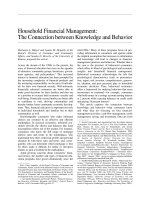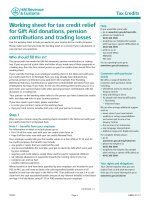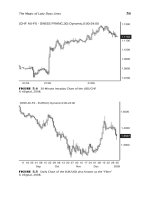Candlesticks, fibonacci, and chart pattern trading forex factory
Bạn đang xem bản rút gọn của tài liệu. Xem và tải ngay bản đầy đủ của tài liệu tại đây (2.22 MB, 273 trang )
CANDLESTICKS, FIBONACCI,
AND C HART P ATTERN
TRADING TOOLS
A SYNERGISTIC STRATEGY TO ENHANCE
PROFITS AND REDUCE RISK
ROBERT FISCHER
JENS FISCHER
JOHN WILEY & SONS, INC.
CANDLESTICKS, FIBONACCI,
AND C HART P ATTERN
TRADING TOOLS
Founded in 1870, John Wiley & Sons is the oldest independent publishing
company in the United States. With off ices in North America, Europe,
Australia, and Asia, Wiley is globally committed to developing and marketing print and electronic products and services for our customers’ professional
and personal knowledge and understanding.
The Wiley Trading series features books by traders who have survived
the market’s ever-changing temperament and have prospered—some by reinvesting systems, others by getting back to basics. Whether a novice trader,
professional, or somewhere in-between, these books will provide the advice
and strategies needed to prosper today and well into the future.
For a list of available titles, visit our web site at www.WileyFinance.com.
CANDLESTICKS, FIBONACCI,
AND C HART P ATTERN
TRADING TOOLS
A SYNERGISTIC STRATEGY TO ENHANCE
PROFITS AND REDUCE RISK
ROBERT FISCHER
JENS FISCHER
JOHN WILEY & SONS, INC.
Copyright © 2003 by Robert Fischer, Dr. Jens Fischer. All rights reserved.
Published by John Wiley & Sons, Inc., Hoboken, New Jersey.
Published simultaneously in Canada.
PHI-spirals, PHI-ellipse, PHI-channel, and www.f ibotrader.com are registered
trademarks and protected by U.S. Trademark Law. Any unauthorized use without
the express written permission of Fischer Finance Consulting AG, CH-6300 Zug,
Switzerland, or Robert Fischer is a violation of the law.
Source of all f igures is FAM Research 2002.
No part of this publication may be reproduced, stored in a retrieval system, or
transmitted in any form or by any means, electronic, mechanical, photocopying,
recording, scanning, or otherwise, except as permitted under Section 107 or 108 of
the 1976 United States Copyright Act, without either the prior written permission
of the Publisher, or authorization through payment of the appropriate per-copy fee
to the Copyright Clearance Center, Inc., 222 Rosewood Drive, Danvers, MA 01923,
978-750-8400, fax 978-750-4470, or on the web at www.copyright.com. Requests to
the Publisher for permission should be addressed to the Permissions Department,
John Wiley & Sons, Inc., 111 River Street, Hoboken, NJ 07030, 201-748-6011,
fax 201-748-6008, e-mail:
Limit of Liability/ Disclaimer of Warranty: While the publisher and author have
used their best efforts in preparing this book, they make no representations or
warranties with respect to the accuracy or completeness of the contents of this
book and specif ically disclaim any implied warranties of merchantability or f itness
for a particular purpose. No warranty may be created or extended by sales
representatives or written sales materials. The advice and strategies contained
herein may not be suitable for your situation. You should consult with a
professional where appropriate. Neither the publisher nor author shall be liable for
any loss of prof it or any other commercial damages, including but not limited to
special, incidental, consequential, or other damages.
For general information on our other products and services, or technical support,
please contact our Customer Care Department within the United States at
800-762-2974, outside the United States at 317-572-3993 or fax 317-572-4002.
Wiley also publishes its books in a variety of electronic formats. Some content that
appears in print may not be available in electronic books. For more information
about Wiley products, visit our web site at www.wiley.com.
Library of Congress Cataloging-in-Publication Data
Fischer, Robert, 1942 June 17–
Candlesticks, Fibonacci, and chart pattern trading tools : a
synergistic strategy to enhance prof its and reduce risk with CD-ROM /
Robert Fischer, Jens Fischer.
p. cm.
ISBN 0-471-44861-3 (hard : CD-ROM)
1. Investments. 2. Securities. 3. Investment analysis. I. Fischer,
Jens. II. Title.
HG4521.F584 2003
332.63′2042—dc21
2003006623
Printed in the United States of America.
10
9
8
7
6
5
4
3
2
1
This book is written for all the traders worldwide who
contacted us on our Web site www.fibotrader.com and
asked for advice.
This book contains a great deal of essential information
for successful trading, but the necessary discipline and
patience can only come from you.
We thank all those traders and friends who have provided help, criticism, and ideas over the past 20 years.
We hope that this book will start a new wave of fruitful
discussion that will benefit all of us.
HYPOTHETICAL PERFORMANCE RESULTS HAVE MANY INHERENT
LIMITATIONS, SOME OF WHICH ARE DESCRIBED BELOW. NO
REPRESENTATION IS BEING MADE THAT ANY ACCOUNT WILL OR IS
LIKELY TO ACHIEVE PROFITS OR LOSSES SIMILAR TO THOSE SHOWN. IN
FACT, THERE ARE FREQUENTLY SHARP DIFFERENCES BETWEEN
HYPOTHETICAL PERFORMANCE RESULTS AND THE ACTUAL RESULTS
SUBSEQUENTLY ACHIEVED BY ANY PARTICULAR TRADING PROGRAM.
ONE OF THE LIMITATIONS OF HYPOTHETICAL PERFORMANCE RESULTS
IS THAT THEY ARE GENERALLY PREPARED WITH THE BENEFIT OF
HINDSIGHT. IN ADDITION, HYPOTHETICAL TRADING DOES NOT INVOLVE
FINANCIAL RISK, AND NO HYPOTHETICAL TRADING RECORD CAN
COMPLETELY ACCOUNT FOR THE IMPACT OF FINANCIAL RISK IN ACTUAL
TRADING. FOR EXAMPLE, THE ABILITY TO WITHSTAND LOSSES OR TO
ADHERE TO A PARTICULAR TRADING PROGRAM IN SPITE OF TRADING
LOSSES ARE MATERIAL POINTS WHICH CAN ALSO ADVERSELY AFFECT
ACTUAL TRADING RESULTS. THERE ARE NUMEROUS OTHER FACTORS
RELATED TO THE MARKETS IN GENERAL OR TO THE IMPLEMENTATION
OF ANY SPECIFIC TRADING PROGRAM WHICH CANNOT BE FULLY
ACCOUNTED FOR IN THE PREPARATION OF HYPOTHETICAL
PERFORMANCE RESULTS AND ALL OF WHICH CAN ADVERSELY AFFECT
ACTUAL TRADING RESULTS.
The following f igures in this book are related to this disclaimer: 4.1, 4.5, 4.13,
4.14, 4.15, 4.20, 4.22, 4.27, 4.28, 4.48, 5.24, 5.25, 5.26, 5.27, 5.28, 5.29, 5.31, 5.34,
6.1, 6.2, 6.3, 6.4, 6.5, 6.6, 6.7, 6.8, 6.9, 6.13, 6.18, 6.21, 6.22, 6.23, 6.24, 6.25, 6.26,
6.27, 6.28, 6.29, 6.30, 6.31, 6.32, 6.33, 6.34, 6.35, 6.36, 6.37.
PREFACE
Many investors are unhappy with the performance of investment advisors and funds in the past couple of years and want to make their
own trading decisions, using the analytic tools and the advice they
have accumulated. This book presents easy, reliable trading tools, together with the trading rules to apply them to real-time trading.
Many investment strategies have been presented in books, market letters, and other media. In this book, we describe those tools that
appear to work best, and we integrate them into a manageable and
understandable trading strategy. Combining different strategies correctly can improve every investor’s chances of success under different
market conditions. Most importantly, we concentrate on strategies
that every experienced investor can easily understand and execute
with the WINPHI charting program that is provided on a CD-ROM at
the end of this book.
With all the sophisticated computer models that are available,
you might think that investing and making money would be getting
easier. But just the opposite has happened. At no time in history has
so much money been lost so fast, and not only the small investors have
suffered. The big investment companies also have had unimpressive
performances even though presumably they had all the necessary tools
to beat the markets. This clearly shows that crunching numbers with
a computer does not ensure success. For many years, we have concentrated on pattern recognition, a technique with proven reliability even
when computers are not available.
•
vii •
viii • PREFACE
Money is not made only by finding good entry points in different
stocks, stock index futures, financial futures, or commodities. Making
money is a strategic game, where it is important to work with stop-loss
and profit targets. Traders make money through systematic investing.
Then they must apply the same concepts to different products to gain
the benefits of diversification.
Being well diversified with a systematic trading approach means
that traders are unlikely to make as much money as they would if they
put all of their investment money in one hugely successful product.
But it makes the investment safer. Millions of investors made and lost
a fortune by betting on high-tech companies. Although they bought
correctly, they did not know when to sell. This book should help you
avoid ever making that kind of mistake again.
Investing systematically has to be learned. Many times, it means
executing trading signals at a loss, often when market letters, media,
or other experts express the opposite opinion. To be comfortable investing against common opinion is crucial for success, but this is possible only for investors who can trust their trading approach. We hope
that with the information in this book, many investors will learn to
make successful trading decisions independently from any other published information.
Making money with a systematic approach requires obeying the
following rules:
• A systematic trading approach, tested on historical data, should
be executed with precision and accuracy (if possible, a computer
should generate the signals).
• Although we concentrate on pattern recognition, candlesticks,
and Fibonacci ratios, other tested strategies should work as well.
• The portfolio should have 5 to 10 products that are all analyzed
using the same trading approach.
• Long and short signals should be allowed.
• Each position should be protected with a stop-loss.
• The profit target should be known once the position is entered.
• Each product should have a historically good trading range.
PREFACE
•
ix
• Each trading strategy should perform in real-time trading according to the philosophy behind the trading concept. For example, a long and f lat strategy cannot make money in bear market
conditions, but it should make money in bull markets.
The first two chapters of Candlesticks, Fibonacci, and Chart Pattern Tools brief ly set forth the psychology and philosophy of successful trading. In Chapter 3, we introduce the basic concepts of the
Fibonacci analysis, candlesticks, and chart patterns. Experienced
traders can skip these preliminaries and go on to Chapter 4, where we
explain how to apply different trading concepts.
The PHI-ellipse is discussed in Chapter 5. We show how it can be
successfully applied to real-time intraday trading. Although the WINPHI program can work with intraday ASCII data as well, it is very slow.
The interested trader can go to our Web site (www.fibotrader.com) and
sign up for a free trial period, to obtain an online trading experience.
We do not offer fully automated trading approaches, but we introduce
readers to some new ways to approach the market.
Finally, in Chapter 6, we combine concepts to demonstrate that
traders can improve their profit chances while reducing their risks.
Although the fascination as well as the beauty of graphic trading tools lies in watching their development from day one, it is difficult
to have the discipline to wait until Fibonacci price or Fibonacci time
goals are reached. Succumbing to the temptation of taking profits a
little bit earlier or placing protective stops a little wider could dilute
the trader’s overall performance profile.
The software has been carefully tested. A User Manual for the program on the CD-ROM is included as an Appendix of this book, to help
users get started in applying all of the charting tools. The concepts in
this book are thoroughly presented and include detailed examples. We
hope that readers find our ideas as inspiring, enlightening, useful, and
exciting, as we do ourselves.
ROBERT FISCHER
JENS FISCHER
Zug, Switzerland, 2003
CONTENTS
CHAPTER 1
TRADING PSYCHOLOGY
INVESTOR BEHAVIOR
AND
1
CHAPTER 2
THE MAGIC FIGURE THREE
7
CHAPTER 3
BASIC PRINCIPLES
9
OF
TRADING STRATEGIES
Fibonacci Analysis
Candlestick Analysis
Chart Pattern Analysis
Trend Lines and Trend Channels
CHAPTER 4
APPLICATIONS
OF
TRADING STRATEGIES
Double Tops and Double Bottoms
Fibonacci Price Corrections
Fibonacci Price Extensions
Candlestick Chart Patterns
3-Point Chart Patterns for Trend Reversals
PHI-Channel Applications
CHAPTER 5
PHI-ELLIPSES
9
24
32
41
45
45
52
67
77
88
108
115
Basic Features and Parameters of PHI-Ellipses
Working with PHI-Ellipses on Daily Data
PHI-Ellipses on Constant Scales
Working with PHI-Ellipses on Intraday Data
Reliability of PHI-Ellipses Reconsidered
•
xi •
116
132
150
155
162
xii • CONTENTS
CHAPTER 6
MERGING CANDLESTICKS, 3-POINT CHART
PATTERNS, AND FIBONACCI TOOLS
Fibonacci Price Correction Levels
Fibonacci Price Extensions
Support and Resistance Lines
PHI-Ellipses
Summary
167
168
187
195
207
218
SOME FINAL REMARKS
221
TUTORIAL
227
LIST
OF
ABBREVIATIONS
229
DISCLAIMER
231
USER MANUAL WINPHI GETTING STARTED
233
INDEX
251
CANDLESTICKS, FIBONACCI,
AND C HART P ATTERN
TRADING TOOLS
1
TRADING PSYCHOLOGY AND
INVESTOR BEHAVIOR
The market price of a stock at any exchange never represents the company’s fair value. The stock instead is trading either above or below
that valuation. Over the past couple of years, the potential discrepancy between market capitalization and fair value became painfully
obvious to investors. Supported by analysts’ unrealistic price forecasts,
many high-tech stocks reached untenable high prices and then, in
some instances, became worthless because there was no real value behind these companies.
In general, the market price f luctuates higher or lower around the
fair value, depending how the market sentiment values the company.
GUIDELINES FOR INVESTORS
In the following sections, we list some rules that can help investors
improve their investment decisions. These guidelines come from our
experience and are not necessarily based on new theories.
•
1 •
2 • TRADING PSYCHOLOGY AND INVESTOR BEHAVIOR
1.
Know Yourself
If you start sweating when you watch the price swings of a product
you have invested in, you either have the wrong trading concept, are in
the wrong products, or your positions are too big.
2.
Put Your Ego Aside
The biggest losses happen after investors make their first big profits.
If you accumulate profits with a proven, tested investment strategy,
you can pride yourself on its success.
However, if you make profits without an investment strategy, you
may lose not only all your prof its but your total investment. Unexpected price moves do not have to mean big losses; they occur because
investors work with the wrong trading concept.
3.
Hoping and Praying Do Not Guarantee Success
Many traders keep repeating the same mistake: They take small profits and let the losses run. The main reason to work systematically
with an investment concept is to get the best average performance.
This requires placing a stop-loss with every trading position and calculating the profit target when opening a position.
Hoping that losses will become prof its by waiting a “little bit
longer” is gambling. It might be appropriate once in a while, but in
the long run, it ruins every account.
4.
Investors Must Learn to Live with Losses
It is easy to enjoy profits, but everyone hates losses. A market price that
drops below the entry price is not the only reason for a loss. If a position with a 100 percent profit is liquidated at the entry price, this is
also a big loss in the account, although it may not seem as damaging.
5.
Never Double Your Losses
Dollar-cost averaging is one of the best strategies for investors if they
execute it systematically as part of a long-term strategy.
GUIDELINES FOR INVESTORS
•
3
Almost all huge bankruptcies in trading companies worldwide
happened because they doubled up losing positions. Hoping to recover
losses through additional leverage never works unless someone is really lucky.
6.
Know Your Pain Level
Investors create their biggest problems when they change their investment strategy without sufficient reason. The trouble begins when
traders jump from one trading strategy to another to follow the shortterm sentiment, mainly because a product seems to have changed.
Each investment strategy has its advantages and disadvantages.
Someone who has expertise in picking stocks should continue to use
this approach, despite the risk of big drawdowns. A perfect trading concept does not exist, unless someone has discovered a niche product and
keeps quiet. At the same moment that this niche market becomes common knowledge, the profit potential disappears.
Each investment strategy has a predetermined pain level that investors can identify. It is important to know this pain level before executing an investment strategy.
7.
Diversify the Risk
No matter how promising the future of a product may seem, diversify
the risk. Many traders profitably trade the same product every day and
are especially successful in intraday trading. But these traders are disciplined and have specific product knowledge that is not available to
most people.
In general, diversifying the risk with a systematic trading approach will result in a much more stable equity curve than investing
in a single product.
8.
Making Money by Trading Is Hard Labor
Many people believe that that it is easy to make money by investing in
stocks, bonds, stock index futures, or commodities.
The opposite is true. Investors who show quick profits through
trading either have inside information or are remarkably lucky. Average investors have neither of these advantages.
4 • TRADING PSYCHOLOGY AND INVESTOR BEHAVIOR
All traders must develop a personal profile of risk preference and
find a systematic trading style that fits the profile. Then they have to
execute it. Months or years of systematic trading may be necessary before real-time trading results confirm that the trading concept works.
9.
Intuition versus Execution of a Tested Trading Concept
All of the information that comes over the tickers, from newsletters,
and through the Internet is already old when we receive it. There will
always be someone with faster access who can take advantage of that
information. Speculating with this “old” information is dangerous.
Trading concepts that have been tested and have good historical
track records on paper provide valid information only if the advisor is
willing to share how the trading concept works.
Real-time trading records are only reliable if market behavior
does not change. Many of the successful fund managers in the 1980s
did less well in the 1990s because the market patterns were very
different. Investors must be highly skilled to identify trading concepts that did not perform well in the past but will perform well in
the future.
10.
The Importance of a Trading Plan
The secret of success on the exchanges is not to make money fast, but
to make it consistently.
One of the most difficult accomplishments for traders is to create a portfolio that builds up equity over the long term, independently
of market conditions. To reach this goal, it is essential to work with a
reliable investment strategy and to guard against being greedy.
11.
Feel Comfortable with Your Trading Strategy
Successful traders begin the morning with a trading concept that they
can use comfortably for executing trading signals throughout the day,
no matter what the markets are doing.
Feel good about your trading strategy as long as the real-time
trading results are in line with the historical test results. If the maximum drawdown gets bigger than the drawdown of the historical test
results, reevaluate the trading concept.
GUIDELINES FOR INVESTORS
12.
•
5
Nothing Is More Important than Discipline
Discipline is always the most important attribute of successful
traders. Many traders fail or have limited success because they cannot
control their emotions and execute their established trading strategy
in any given market situation.
13.
Value of Available Trading Concepts
Many worthwhile trading concepts are available. But none of them
will always make money. An effective trading concept does not have to
be difficult, but it must be executable. The trader has to believe in it
and be willing to trade it even after a string of losses.
2
THE MAGIC
FIGURE THREE
In presenting Fibonacci Trading tools, candlesticks, and chart price
patterns, we concentrate on the ones that have a high analytical value
and can be combined with each other. Our goal is to avoid information
overf low, while providing adequate detail, because all of the strategies can be important in different market situations.
A key question is whether all of these patterns have a common
denominator. The answer is a definitive “yes”—all of them include the
figure three:
• Three waves in price extensions.
• Three waves as the basic structure of the PHI-ellipse.
• Three peaks and valleys in triple top/ bottom chart patterns.
• Three peaks and valleys in head and shoulder formations.
• Three peaks (or valleys) in symmetrical, ascending, or descending triangles.
• Three rising valleys and three falling peaks formations.
• Three peaks or valleys in rectangles, f lags, wimples, wedges, and
other chart formations.
•
7 •
8 • THE MAGIC FIGURE THREE
Traders who analyze only chart patterns that feature the figure
three and eliminate all other formations may lose some price moves,
but their overall analysis will be safer and more accurate because they
will know what to look for on the price charts. The biggest advantage
of this approach is that most investors can identify patterns and execute corresponding trading strategies with or without a computer.
Figure 2.1 shows eight relevant chart patterns based on the
figure three.
Figure 2.1
Chart patterns including the magic figure “three.”
As explained in the following chapters, the PHI-ellipse is the best
trading instrument for daily and intraday trading. What makes this
trading tool interesting and unique is its ability to surround most
chart patterns that include the figure three. Whenever we can integrate chart patterns into the PHI-ellipse, it allows us to work with
only one trading tool. This is why in this book we focus on trading tools
that have similar characteristics, and many times we identify the same
turning points or breakouts, but from a different perspective.









